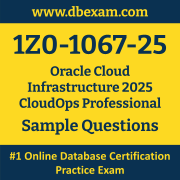01. Which two options show the correct scope for setting up Oracle Cloud Infrastructure budgets?
a) Namespace
b) Tenancy
c) Compartment
d) Cost-tracking tag
e) User-defined tag
02. How can you provide user access to an existing compartment in Oracle Cloud Infrastructure?
a) By granting access directly to the user when the user is created
b) By granting users access to the compartment when the compartment is created
c) By adding users to a compartment. All users in the compartment will have access to the resources in the compartment.
d) By adding users to a group and defining a policy to provide group access to the compartment
03. Which three tasks can be done using Ansible?
a) Audit
b) Application deployment
c) Workflow automation
d) Analytics
04. What is the most secure place to store secret keys on Oracle Cloud Infrastructure?
a) Vault
b) Code files
c) Cloud Guard
d) Config files
05. Which two statements are true about Oracle Cloud Infrastructure (OCI) Command Line Interface (CLI)?
a) The CLI allows you to use the Python language to interact with OCI APIs.
b) You can filter CLI output by using the JMESPath query option for JSON.
c) You can run CLI commands from inside OCI Regions only.
d) The CLI provides the same core functionality as the Console, plus additional commands.
e) The CLI provides an automatic way to connect with instances provisioned on OCI.
06. When would you use a load balancer instead of a Network Load Balancer in Oracle Cloud Infrastructure (OCI)?
a) When you require SSL/TLS termination and HTTP/HTTPS load balancing
b) When you are working with latency-sensitive applications
c) When the backend is located in different availability domains
d) When you need source and destination IP addresses, and port preservation
07. Which three algorithms are supported by Vault?
a) DES
b) AES
c) RSA
d) ECDSA
e) OWASP
08. Your company is growing fast and you have been asked to migrate alarms to a new compartment in the company's Oracle Cloud Infrastructure (OCI) tenancy.
Which set of steps do you perform to migrate alarms in OCI from one compartment to another?
a) In the OCI console, select the alarm, List Scope, and select the compartment.
b) In the OCI console, click Alarm Definitions, List Scope, and select the compartment. Click Move Resource and choose the destination compartment.
c) In the OCI console, click the compartment, List Alarms, and select the compartment. Click Move Resource and choose the destination compartment.
d) In the OCI console, click Alarm Definitions and select the compartment. Click Move Resource and choose the destination compartment.
09. Which two statements about the Oracle Cloud Infrastructure Cost Analysis Tool are true?
a) Costs can be filtered by Date, Tags, and Compartments.
b) Costs can be filtered by Compartments, Date, and Service Limit.
c) The tool can be accessed by all users.
d) The tool can only be accessed by members of the ADMINISTRATOR group.
10. Which statement is true about Oracle Cloud Infrastructure paravirtualized block volume attachments?
a) Paravirtualized volumes become immediately available on bare metal compute instances.
b) Paravirtualization uses the internal storage stack of compute instance OS and network hardware virtualization to access block volumes.
c) Paravirtualized volumes may reduce the maximum IOPS performance for larger block volumes.
d) Paravirtualized is required to manage iSCSI configuration for virtual machine instances.
 The Oracle Cloud Infrastructure CloudOps Professional (1Z0-1067-25) Sample Question Set is designed to help you prepare for the Oracle Cloud Infrastructure 2025 Certified Cloud Ops Professional certification exam. To become familiar with the actual Oracle Certification exam environment, we suggest you try our Sample Oracle 1Z0-1067-25 Certification Practice Exam.
The Oracle Cloud Infrastructure CloudOps Professional (1Z0-1067-25) Sample Question Set is designed to help you prepare for the Oracle Cloud Infrastructure 2025 Certified Cloud Ops Professional certification exam. To become familiar with the actual Oracle Certification exam environment, we suggest you try our Sample Oracle 1Z0-1067-25 Certification Practice Exam.